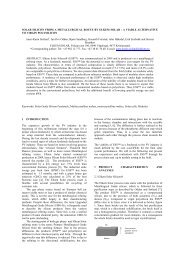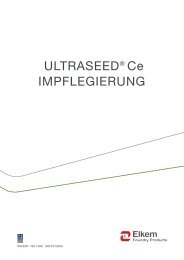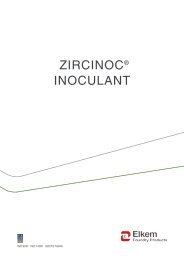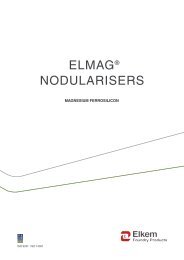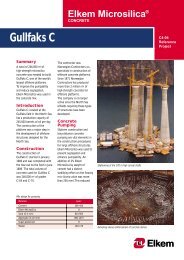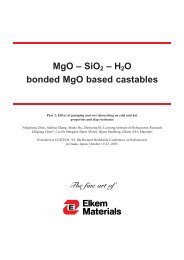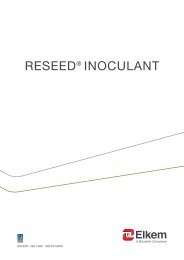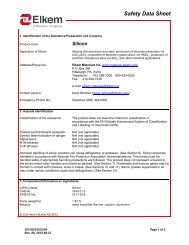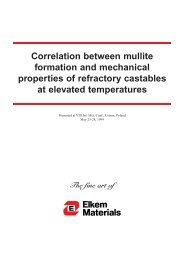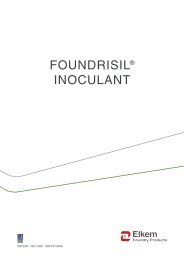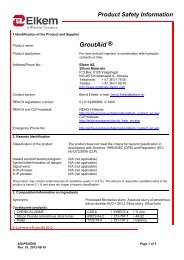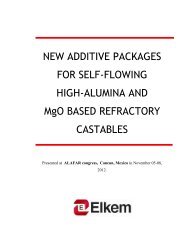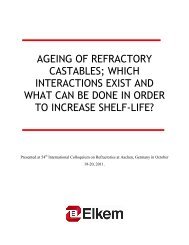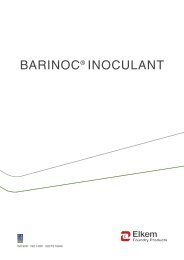The Use of Microsilica in Refractory Castables - Elkem
The Use of Microsilica in Refractory Castables - Elkem
The Use of Microsilica in Refractory Castables - Elkem
- No tags were found...
Create successful ePaper yourself
Turn your PDF publications into a flip-book with our unique Google optimized e-Paper software.
most difficult aspect <strong>of</strong> refractory castable technology. One way <strong>of</strong> monitor<strong>in</strong>g the evolution <strong>of</strong>this first stage <strong>of</strong> sett<strong>in</strong>g is by measur<strong>in</strong>g the flow <strong>of</strong> a castable as a function <strong>of</strong> time, commonlycalled flow decay measurements.For the flow decay measurements, sufficient material was mixed to perform a number <strong>of</strong> flowtests. This amount was stored <strong>in</strong> a conta<strong>in</strong>er either covered with a moist blanket or with a tightlid to avoid evaporation. At a predeterm<strong>in</strong>ed time, a sample was taken and flow was testedaccord<strong>in</strong>g to the procedure described under Examples, Flow above. Flow decay was testedon the compositions <strong>in</strong> Table 2 and 3 with different additions <strong>of</strong> retarder (citric acid) and at 5,20 (ambient) and 35°C, with emphasis on 35°C For the test<strong>in</strong>g at 5 and 35°C, thehomogenized dry mix was tempered overnight <strong>in</strong> a refrigerator or heat<strong>in</strong>g cab<strong>in</strong>et prior tomix<strong>in</strong>g with tempered water. After wet mix<strong>in</strong>g, the castable was stored <strong>in</strong> the temperaturecontrolled enclosure and samples were withdrawn from this at test time.Flow decay and particle size distribution:Figure 5 shows the free-flow <strong>of</strong> ultralow-cement castables with different particle sizedistributions as a function <strong>of</strong> time. <strong>The</strong> temperature was 20°C. <strong>The</strong> raw materials are the sameas for the ULCC presented <strong>in</strong> Table 2, but the composition was changed to accommodate forthe different particle size distributions represented here by their distribution coefficients (qvalues).13 volume% water was used. We see that the free flow is significantly <strong>in</strong>fluenced bythe q-value, lower q-value gives higher free flow. <strong>The</strong>se results are <strong>in</strong> accordance with earlierdata stat<strong>in</strong>g that high free flow is atta<strong>in</strong>ed by the use <strong>of</strong> particle size distributions with low q-value. A low q-value implies a high level <strong>of</strong> microsilica, here q-values <strong>of</strong> 0.28, 0.25 and 0.22represents microsilica contents <strong>of</strong> 4.5, 8 and 10% respectively. A full list<strong>in</strong>g <strong>of</strong> the castablecomposition is given <strong>in</strong> reference. 24 Additional to the fact that low q-values improve free flow,also the time it takes until the free flow start to decl<strong>in</strong>e is proportional to the microsilicacontent. It has been known, s<strong>in</strong>ce the appearance <strong>of</strong> the low-cement castables, that microsilicacould have a retard<strong>in</strong>g action on set. One have sought to expla<strong>in</strong> this behavior by themicrosilica cover<strong>in</strong>g the cement surface and thereby h<strong>in</strong>der the dissolution <strong>of</strong> the cement.Without judg<strong>in</strong>g the contents <strong>of</strong> such theories, one may simply state that more microsilica <strong>in</strong> acastable mixture seems to have a retard<strong>in</strong>g effect. Here the effect is that a castable with a q-value <strong>of</strong> 0.25 (8% microsilica) makes it possible to ma<strong>in</strong>ta<strong>in</strong> free flow for around 3 hourswhereas a q-value <strong>of</strong> 0.28 (4.5% microsilica) leaves little time until the flow decaycommences.



